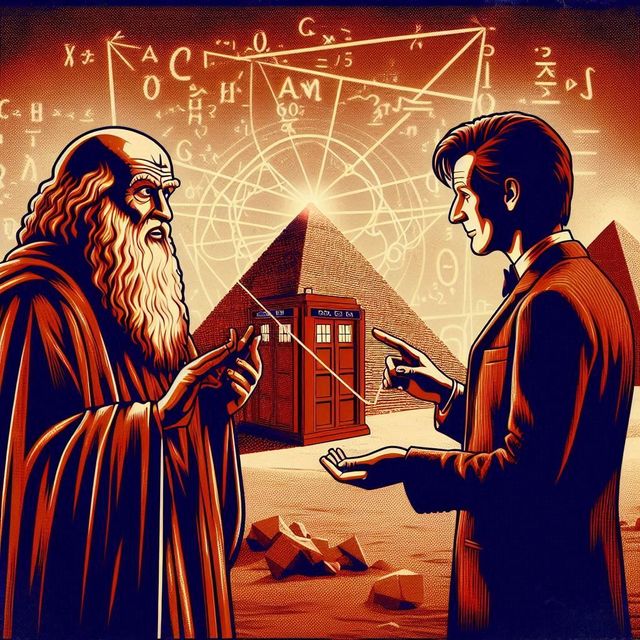-
Vijay Fafat
- Published on
A short story involving the 13th doctor, a female, and (a drunken) Pythagoras, with his daughter, Myia. The piece deftly uses the idea that certain types of geometric patterns act as magical talismans and portals to other dimensions. In particular, it attaches a significance to the fourth triangular number, 10, as a magical entry point into the fourth dimension. Pythagoras’ belief in metempsychosis, the transmigration of souls, fits quite nicely in the story.
On a lark, the good doctor decides to revisit Pythagoras in Croton, circa 500 B.C. Myia, gets possessed by an interdimensional entity, “some kind of quantum life-form”. Turns out that the entity, “Zaris of Argomeld”, is lost in our universe and the way for it to get back to its reality is through a gateway opened up by a geometrical pattern, the “tetractys”. To quote:
Milo pulled a face, undecided. ‘Well, there is the business with the tetractys appearing in unexpected places …’
‘The what?’ said Ryan.
‘My geometrical representation of the fourth triangular number,’ Pythagoras enthused.
‘Ten equal points arranged in four rows of four, three, two and one.’
‘Whoa,’ Ryan said, holding up his hands in surrender. ‘I smell maths.’
‘The tetractys is a mystical symbol for all followers of Pythagoras.’ Milo took up a slate and a piece of chalk and, with the help of the torchlight, started to make a series of large dots to represent the ten points of the diagram. ‘Four, then three, then two, then one; like this.
[…]
‘There’s another aspect of the tetractys that Pythagoras hasn’t mentioned yet,’ the Doctor said quickly, circling the slate and its ten equally-spaced dots with what could only be described as great caution. ‘The first dot represents zero dimensions. The second row – the two dots – represents one dimension, as if there’s a line drawn between them. The third row represents two dimensions, and the fourth row three.’
[…]
‘Together these separate and important dimensional forces can be made to interact with the right kind of key,’ explained the Doctor – not altogether successfully, if the puzzled looks on her friends’ faces were anything to go by. She drew a huge triangular shape in the air with her hands. ‘A key to unlock a doorway!
The doctor conjectures that the Argomeld itself is:
“an entity derived from quantum mathematics. I think it locks on to life in our universe at a molecular level, a tiny mathematical DNA sequence maybe, insinuating itself into the simplest form of life, a single-celled organism. Then it starts a series of transmigrations, moving from one physical form to another, each more complex and sophisticated than the last… leapfrogging up the food chain … a worm, a rodent, and then maybe a dog – before finally transferring to a human being. The Argomeld will use the human to power its final transference through a tetractic teleport.”
To protect Myia and enable a safer transmigration process for Zaris, the Doctor has 10 people create a human tetractys for the final climax…
And what is an “Argomeld”?
‘I don’t know,’ Myia confessed. ‘A glimpse of something we should never even try to imagine. If you could lift the universe up like a rock in your garden, then maybe that’s what you’d find lurking beneath. Something that only exists in the dark. The Argomeld was an extension of it, I think, or perhaps an emissary.’
